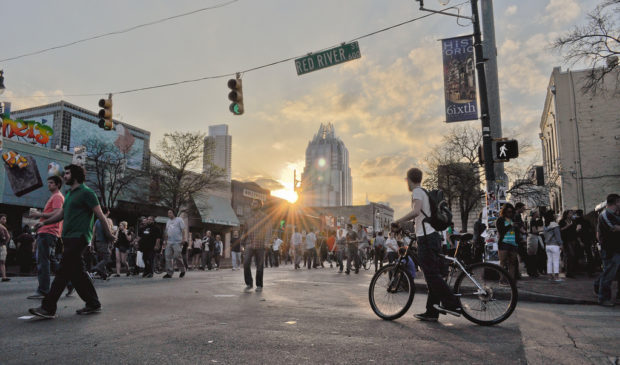Council looks to Waller Creek TIF for homeless funds
Wednesday, August 30, 2017 by
Jack Craver City Council is looking to tax increment financing, a tool designed to address urban blight, as a way to address homelessness in downtown Austin.
Council is considering extending the life of the Waller Creek Tax Increment Financing Reinvestment Zone for an additional 12 years (from 2029 to 2041) as well as its boundaries in the hopes of capturing an additional $140 million in property tax revenue, some of which could be dedicated to homeless services.
In a presentation to Council during a work session on Tuesday, city of Austin Interim Chief Financial Officer Greg Canally proposed that $110 million of the additional revenue could be spent on fulfilling the Waller Creek Design Plan, while $30 million could be directed to homelessness.
The current borders of the reinvestment zone are I-35 to the east, Red River Street to the west (although the lower third juts further west to Trinity Street, including much of the Austin Convention Center), Lady Bird Lake to the south and East 12th Street to the north. The proposed expansion would go north to 15th Street and west to Trinity Street.
Like many other issues, Council’s desire to spend to help the homeless is sharply restricted by state law.
While the city could use the funds generated by the TIF district to build temporary shelters, it will not be able to spend the money to create permanent affordable housing. The state considers long-term affordable housing to be an “economic development” expense, meaning that the city may only issue debt to cover it with approval from voters via referendum.
“I was not excited to hear that,” said Mayor Pro Tem Kathie Tovo.
Recalling Council’s recent decision to explore a “tax swap” with the Austin Independent School District, Tovo wondered whether the city could explore a similar deal with the Waller Creek Conservancy, the nonprofit that raises money to help the city complete the linear park. Under such a scenario, Council would presumably devote all of the public dollars raised by the TIF to the parks project in exchange for the organization funding the construction of housing.
Council Member Ann Kitchen also urged city staff to do “more analysis” of what types of housing projects Council can use the TIF dollars on.
Regardless, warned Assistant City Attorney Leela Fireside, “[a]ny type of public financing that we issue has to go to the attorney general’s office to get approval.”
The TIF zone is one of two mechanisms that city staff has suggested could fund a number of downtown priorities that Mayor Steve Adler has dubbed “the downtown puzzle.” Those include expanded homeless services, an expansion of the Austin Convention Center, the implementation of the Waller Creek linear park and a number of cultural projects and mobility improvements.
The other principal financial tool staff has floated is an increase in the Hotel Occupancy Tax. However, state restrictions on how that revenue can be used are even greater. All of it must be spent either on the convention center, promoting tourism, or arts and historic preservation projects that are likely to attract tourists or convention attendees. Homeless shelters are definitely out of the question.
State law specifies that TIF reinvestment zones are meant to address urban blight. The statute describes a number of acceptable examples of blight, such as a “substantial number of substandard, slum, deteriorated or deteriorating structures,” “unsanitary or unsafe conditions,” or “the predominance of defective or inadequate sidewalk or street layout.”
Considering that property values in downtown Austin have increased roughly 300 percent over the past 15 years (nearly triple the increases experienced by the city as a whole), it’s not hard to imagine a legal objection to the Waller Creek TIF.
However, former Mayor Pro Tem Sheryl Cole, who pushed for the creation of the TIF zone during her time on Council and was at City Hall on Tuesday watching the discussion, described the homelessness issue as an existential threat to downtown’s continued prosperity.
“I support the convention center expansion but the expansion or even the convention center or even our existing downtown will not continue to prosper unless we deal with this,” she said. “I don’t even know that the hoteliers have really, truly grasped that.”
Photo by Davidlohr Bueso made available through a Creative Commons license.
The Austin Monitor’s work is made possible by donations from the community. Though our reporting covers donors from time to time, we are careful to keep business and editorial efforts separate while maintaining transparency. A complete list of donors is available here, and our code of ethics is explained here.
You're a community leader
And we’re honored you look to us for serious, in-depth news. You know a strong community needs local and dedicated watchdog reporting. We’re here for you and that won’t change. Now will you take the powerful next step and support our nonprofit news organization?









